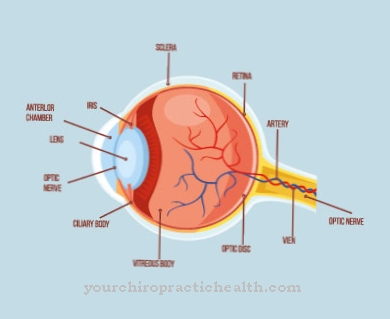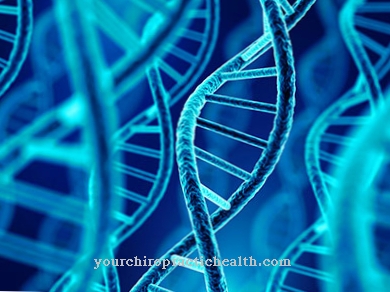A Cholestasis, biliary obstruction, biliary obstruction or Cholestasis syndrome is a pathological disorder of the drainage pathways of the bile. There is a build-up of toxins in the body, which were formed by the liver and have to be eliminated through the intestine. A typical sign of cholastasis is jaundice. Furthermore, the urine turns brown and stool discoloration. Abdominal pain and itching are also common side effects. Cholestasis should be evaluated and treated promptly by a doctor.
What is cholestasis?

© blackday - stock.adobe.com
The bile is produced in the liver and then stored in the gallbladder.
If necessary (mainly through food stimuli), the digestive juice is now released into the duodenum via the biliary tract. The close proximity to the pancreas is also clinically relevant.
If there is a congestion in the area of the bile drainage, the doctor speaks of a cholestasis or bile congestion. This bile congestion can be detected early in the laboratory (using the so-called cholestasis parameters gamma-GT, alkaline phosphatase (AP) and the yellow blood pigment bilirubin). Symptoms appear much later.
causes
The most common cause of cholestasis is an uptight gallstone. This usually arises in the gallbladder and can then go on a journey. If this becomes stuck in a bile duct, cholestasis occurs in addition to the typical colic-like pain. Risk factors are the often cited "5xF": women (female), around 40 years old (forty), overweight (fat), fertile (fertile) and light skin color or blond (fair).
Unfortunately, painless cholestasis is not infrequently the result of a malignant tumor of the pancreas. Since this cancer usually grows in the upper area, it then mechanically relocates the bile ducts and thus leads to bile congestion.
Other causes are less common. Examples of this are inflammatory diseases (e.g. primary sclerosing cholangitis, which is usually associated with rheumatic or chronic inflammatory bowel diseases), cicatricial adhesions after operations (e.g. after removal of the gallbladder) or tumors of the bile duct system (e.g. the so-called Klatskin tumor with an extremely poor prognosis ).
Symptoms, ailments & signs
Depending on the cause, cholestasis can cause various symptoms and ailments. Bile congestion initially manifests itself through the typical signs of jaundice - yellowish skin, sweats, dark circles under the eyes and tremors. These external symptoms are accompanied by gastrointestinal complaints.
As a result of the impaired kidney function, gas and abdominal pain occur, for example, and a feeling of fullness often occurs. The pressure on the surrounding organs can also lead to sudden vomiting. The lack of bile salts results in chronic, usually excruciating itching. This is usually accompanied by other skin irritations.
Some patients have unusual redness or eczema on the skin, which increases in intensity as the disease progresses. If the cholestasis occurs as a result of a tumor disease, it is usually painless. In the further course, however, jaundice and the other symptoms mentioned at the beginning can occur. In the absence of treatment, biliary stasis results in perforation of the gallbladder.
The rupture of the gallbladder manifests itself in acute, cramp-like pain and severe nausea. When the gallbladder empties into the abdominal cavity, the peritoneum becomes inflamed. It can also lead to pancreatitis and other serious illnesses, which in turn are associated with symptoms and complaints.
course
Depending on the cause, cholestasis may be accompanied by massive pain, e.g. if the bile duct is suddenly blocked (especially by gallstones). Cholestasis due to tumors (which block the duct over a long period of time), on the other hand, are usually painless.
Regardless of the cause, cholestasis leads to biliary backlog in the liver. Bile salts, which are deposited in the skin, can no longer be released via the bile. This leads to excruciating itching.
The bilirubin, which gives the bile its color, is now alternatively excreted through the kidneys (dark brown urine) and no longer through the stool (light yellow to white stool).
The liver can also only function to a limited extent under the circumstances. Other disorders (for example in the area of blood clotting or in the protein balance) can arise as a result.
Complications
Cholestasis is usually associated with various complications and risks. First of all, the backlog of the bile leads to an overload of the liver, which in extreme cases can lead to permanent liver damage or liver failure. Cholestasis is usually accompanied by inflammation of the biliary tract and the surrounding organs, which increases the risk of perforations, gallstones or tumors.
If the outflow of bile into the small intestine is also disturbed during cholestasis, a so-called gallbladder hydrops can occur, which in turn can lead to perforation of the gallbladder. Serious complications are to be expected if the gallbladder ruptures. The emptying into the abdominal cavity often leads to inflammation of the peritoneum, pancreatitis and other serious diseases, which in turn are associated with various complaints and risks.
The treatment can lead to complications from removal of the gallbladder. As part of the postcholescystectomy syndrome, abdominal discomfort, stomach and intestinal ulcers or inflammation of the gastric mucous membranes can occur, which can lead to further symptoms undetected. However, early clarification of gallbladder complaints can reliably prevent the development of most complications.
When should you go to the doctor?
Cholestasis is a very serious disorder that must be clarified promptly by a doctor.
In the more harmless cases, a jammed gallstone is the trigger for bile congestion. This particularly often affects women around 40 years of age who are still fertile, are overweight and often have a very light skin color. Since a jammed gallstone can cause very painful cholics in addition to biliary congestion, patients belonging to this risk group should consult a doctor as soon as the first signs of biliary symptoms appear.
If cholestasis is not accompanied by pain, a doctor's visit is all the more urgent, as the trigger can then be a malignant tumor of the pancreas. The earlier this is treated by a specialist, the better the prognosis for the patient concerned.
If cholestasis is not treated in a timely manner, regardless of the cause of the disorder, biliary backlog in the liver often occurs. The bile salts, which can no longer be excreted, then begin to accumulate in the skin, which is associated with unbearable itching. Patients can usually avoid this by consulting a doctor in good time. The first point of contact is the family doctor if cholestasis is suspected. If you have acute cholism, you can go to the nearest hospital straight away.
Doctors & therapists in your area
Treatment & Therapy
The causal therapy of cholestasis or biliary congestion depends on the underlying disease. For gallstones, e.g. the exit into the duodenum is widened (papillotomy) so that the stone can come off. If this is not enough, the stone is recovered endoscopically using a basket. In the course of the process, the gall bladder should be removed as the culprit. If there is a pancreatic tumor, it can be surgically removed (so-called Whipple operation). In many cases the tumor is inoperable by the time the first symptoms appear.
Chemotherapy can be carried out to extend life (but not curative). Similar therapeutic approaches are used for a bile duct tumor. Antibiotics and steroids can be used successfully for inflammatory causes.
However, symptomatic therapy is also important. The patients suffer primarily from the excruciating itching. Urea lotions and cool washes can provide relief. The disturbed fat digestion can be supported by digestive enzymes in the form of a tablet or capsule.
Outlook & forecast
Depending on the cause, cholestasis can develop very differently. Basically, biliary congestion has a positive prognosis. If treatment is started early, symptoms will disappear after a few days. As a rule, there are no long-term consequences of cholestasis.
However, if the symptoms are based on a serious condition such as a tumor, the prognosis is less positive. Tumor disease is always associated with certain risks, for example metastases, chronic pain and the consequences of radiation treatment.
The bile congestion itself can be alleviated with the help of medication and conservative measures such as rest and bed rest, but the cause usually requires further investigation and treatment. The prognosis is positive if the biliary obstruction is only due to a jammed gallstone, obesity or swelling. In these cases, the symptoms subside as soon as the underlying disease has subsided.
If the symptoms are caused by a Klatskin tumor or even a malignant tumor of the pancreas, the prognosis is poor. Life expectancy is usually greatly reduced. The success of the treatment depends on the patient's constitution, the chosen form of therapy and numerous other factors.
Aftercare
Since cholestasis itself is only a symptom, follow-up care is primarily based on the existing cause. If there is only a temporary obstruction, e.g. due to a tumor, the biliary congestion regresses after surgical removal. In the following months, patients should have their liver values, inflammation parameters and cholestasis markers determined in the blood again and again in consultation with the treating doctor.
In this way, the regeneration of the liver parenchyma and any irreversible damage that may exist can be assessed. If the cholestasis is caused by gallstones, regular ultrasound examinations should be carried out so that newly forming stones can be recognized directly. If the cause of the biliary obstruction could not be eliminated, the biliary obstruction can repeatedly lead to symptoms and problems.
Here jaundice and the associated itching are predominant. This can be treated with an on-demand medication. Even after an acute phase, patients should take care of their liver. Large amounts of alcohol and drugs that damage the liver should be avoided. This also includes pain relievers such as paracetamol.
In addition, a balanced, low-fat diet should be observed. Each patient should be educated about the warning signs of liver damage and cholestasis in order to identify them. These include, for example, the yellowing of the skin and sclera, an increased susceptibility to infections or an increased tendency to bleed.
You can do that yourself
Recommended behavior in everyday life and self-help measures that can be used in the event of cholestasis or biliary congestion depend on the causes of the disease. At the first signs of biliary congestion, which usually manifests itself as jaundice-like symptoms, a specialist should definitely be consulted. As a rule, he can clarify the causes.
In most cases, these are gallstones that block the bile ducts and cause very painful cholestasis. In less common cases, a tumor in the pancreas can gradually relocate the bile ducts without pain. This means that pain-free biliary backlogging requires particularly rapid clarification because there is a suspicion of an aggressive pancreatic tumor, which is only operable in the initial phase.
In addition to therapy aimed at eliminating the causes of cholestasis, the use of lotions containing urea on the skin and cooling compresses or compresses can alleviate the severe itching that is usually present. The itching is caused by pent-up bile salts that are secreted into the skin in the form of tiny crystals.
In parallel, a low-fat diet and the intake of digestive enzymes can alleviate the effects of disturbed fat digestion as further self-help measures. Any self-help measures should only take place as an accompanying measure. Eliminating the cause of the biliary congestion is of elementary importance in order to limit the possible harmful effects.





.jpg)





















